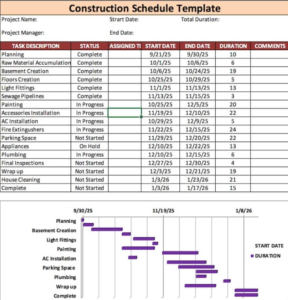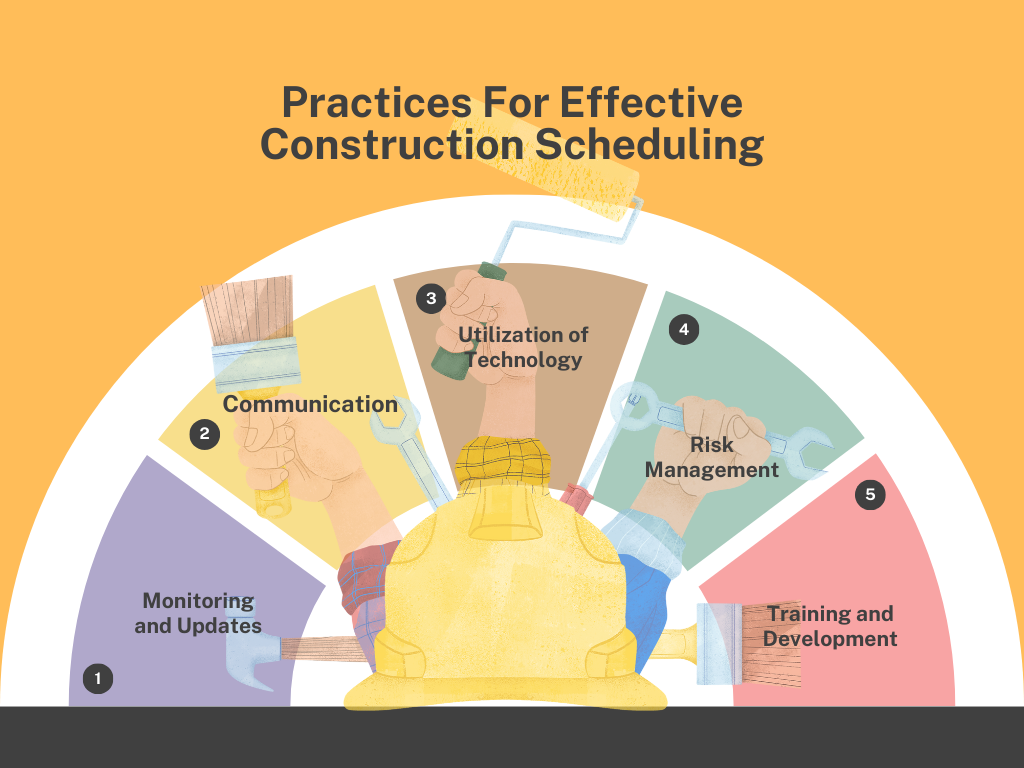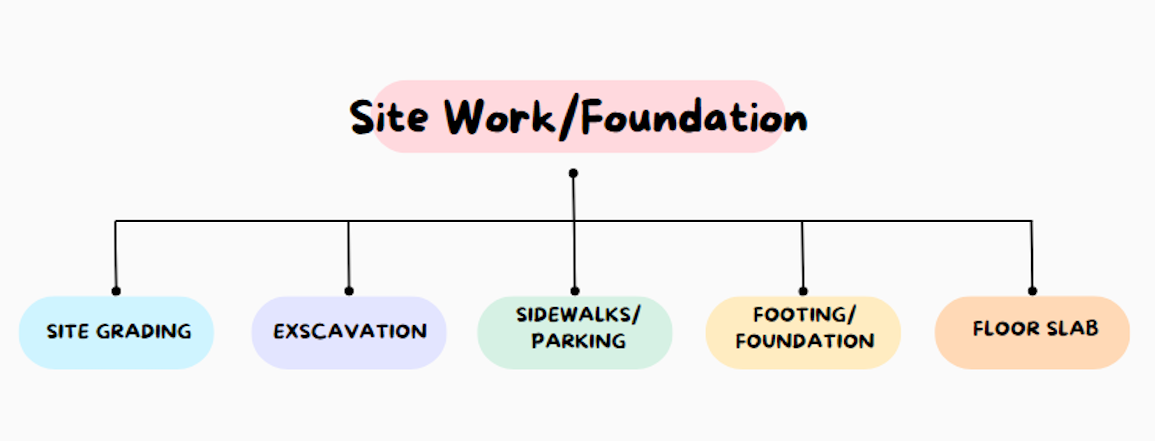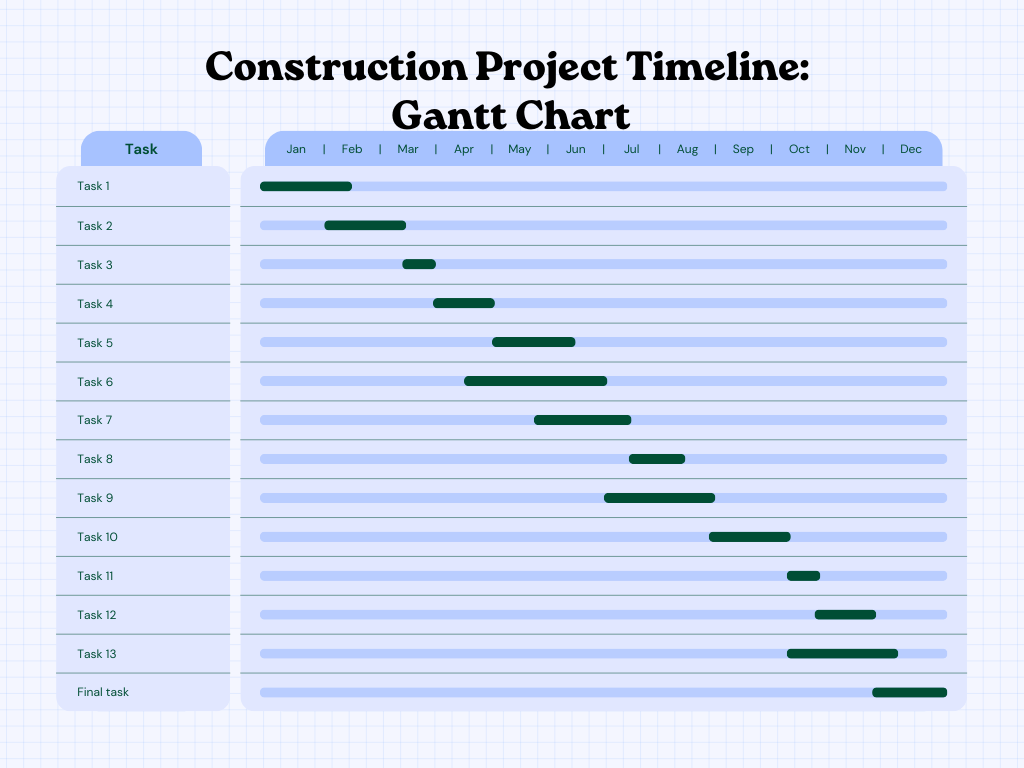In the rising world of construction, Imagine that chaos will sit in silence with efficient implementation of a dynamic construction scheduling plan that will harbor a successful, well managed, cost-effective and timely completed project.”
As the construction industry grows rapidly, being organized is crucial in the planning and scheduling process because this process alone is the backbone of any successful project. As a general contractor and engineer, you wholeheartedly understand that construction isn’t just about building structures; it’s about conducting a very complex smorgasbord of events simultaneously, along with other various activities, resources, and timelines, to certify a coherent project result. When you are dealing with Construction planning and scheduling it involves more than just chronology; it’s a strategic plan that coordinates and improvises every single characteristic of the active project. It is the very tool that organizes and converts all industry chaos into a well-maintained discipline that, in return, enables you as the professional to sufficiently manage all project resources and precede challenges to fulfill the project on time and within the budget.
In this guide, we get deep into the grits of construction scheduling and take a look at the most favorable recipe for success. We will take the complications out of the path even though we are looking at the critical path method scheduling. We will know where to find everyone and everything we need using resource allocation, and we do this crucial endeavor with real-time accommodation. Whatever type of construction project you are managing, small or large-scale, the topics outlined here will ultimately help you navigate through the diverse complexities of the immense construction process and achieve your desired results.
Let’s face it: a construction project does not have one “Jack-of-all-trades,” and too many irons in the fire will cause a meltdown somewhere along the way. The next logical step in going forward would be the very strategic process called construction planning and scheduling.
This process is the silence in the chaos, and where the technical planning comes in, and some of the irons are being cooled down. In a construction project, we need a few key elements: a plan, a where, and, of course, a when and a who. These key elements form a construction schedule and are the pillars of a successful construction scheduling process.
What is Construction Scheduling?
Imagine you going to work one day within your profession of course. Let’s imagine that when you arrived, no one was there, you looked at your watch and you were on time. However, you waited for the first person to arrive just 30 minutes later and they implied that they thought the meeting time was 30 minutes from their arrival.
You can’t proceed because the tools needed to start are in another colleague’s possession, so you have to wait; your day has begun with a domino effect. The day seemed as if all of the challenging aspects of your profession simply woke up and proceeded without a brain. The end result of the day was a stressful chaos without a strategic comeback.
Now let’s imagine you took every challenge known to your profession, and you installed a brain with direct activity demands, an active time, and a completion time. All tools, equipment, and manpower that will be necessary for completing the demands, you took all considerations of any possibility of issues, and then you sent the memo to everyone, and they replied that everyone is on the same page and has seen the visual picture.
The end result is the chaos though it needed to explode it simply could not, silenced thanks to your installed brain that demanded a strategic planning and scheduling effort. The workflow is progressing, and your position becomes easier. This is what construction scheduling does, silences chaos.
Construction scheduling is the process where you begin planning and placing things together by organizing and controlling the project activities, resources, and appointed timelines within the project construction schedule.
The construction schedule organizes everything and the construction project scheduling process serves as a roadmap throughout the construction of the project.
Schedules in construction critiques and organizes not only inventory and schedules but it breaks everything down using very thorough methods.
Prosperous schedules in construction will outline what, when, how long, and who it will take for tasks to be done. By having this type of data in the construction schedule, it is easier to place things in a successful sequence. A successful construction project scheduling sequence will save time and money and, of course, result in a chaotic silence of a stress-free project.
Chaos has its way of intrusion and beyond one’s control even with schedules in construction.
An ideal construction schedule will consider many various factors that may occur, such as labor availability, supply chain delays, inclement weather, or anything else that could delay time in between.
In the construction industry, we can agree it can be even more beneficial to have construction project scheduling when starting a new project. Let’s take a little more technical glance at the importance of Construction Project Scheduling.
Important Factors and Benefits of Construction Scheduling
1. Time Management and Efficiency
- Minimizing Delays: A well-defined schedule helps to identify critical paths and potential “wrenches in the spokes,” allowing for proactive measures to prevent any delays no matter how horrendous it is.
- Optimizing Resources: It makes a clean, fast, and easier way of allocating resources like manpower, equipment, and materials while reducing idle time and more unnecessary costs.
2. Controlling Cost
- Budgeting Adherence: When having tasks in alignment with budgeting constraints and proficient timeline scheduling helps in controlling sufficient costs and avoids overruns or any unnecessary spending.
- Mitigating Possible Financial Risks: Early identification and detection of schedules in construction deviations allows for timely adjustments, preventing financial repercussions.
3. Managing Risk
- Anticipating the Challenges: Being able to Identify risks such as unpredictable weather or supply chain disruptions beforehand enables proactive and smart mitigation strategies.
- Enhancing Safety: Proper scheduling ensures that safety measures and protocols are integrated into task timelines, promoting a safe working environment.
4. Communication and Coordination
- TEAM Alignment: A clear operational schedule will provide effective communication among the entire team and stakeholders, ensuring everyone is aware of the project’s milestones and expectations.
- Collaboration/Elaboration: Communication is Key, and it will provide a clear path to teamwork and coordination among subcontractors, suppliers, and project teams, enhancing overall project synergy and making sure everyone is on the same page at the right moment of time.
Communication isn’t the only Key to building a construction schedule. Let’s take a look at some more key components while we are on the topic of “What is construction scheduling.”
One could never truly know how to create a construction schedule without knowing these key components.
Key Components of Construction Scheduling
1. (WBS) Work Breakdown Structure
- WBS: WBS simply refers to breaking down the project into smaller manageable groups.
This process provides a more hierarchical view of project deliverables, aiding in task sequencing and resource allocation.
2. Activity
A project schedule activity is a piece of work that is part of a larger work package in a project.
3. Activities
Sequencing and Relationships: Activity sequencing refers to planning activities to happen in a certain order (sequentially, concurrently, with lag time or no lag time). In other words, the certain order of performing a group of activities with available resources.
Gantt Charts:
- Visualization Tool: This is a graphic representation of tasks, durations, and dependencies over a timeline.
- Gantt Chart Benefits: Gantt Charts will offer a clear overview of the project timeline and its signs of progress while facilitating adjustments and resource leveling when needed.
4. (CPM) Critical Path Method
- An Analytical Technique: This analytical technique simply identifies the longest sequence of dependent activities, determining the project duration.
- The Application: The application will help to prioritize tasks along with managing resources efficiently to avoid any delays.
5. Resource Allocation
- The Balancing Act: This is the acrobatics of assigning resources (labor, equipment, materials) based on the project’s segments and availability.
- Efficiency Boost: This is what ensures that resources are utilized optimally without overloading or underutilization.
6. Constraints and Dependencies
- Identifying Factors: Take Consideration of external factors (weather, permits) and task dependencies and needs (finish-start-start) that influence the project timeline.
- Management: By anticipating constraints and dependencies this aids in creating realistic schedules and contingency plans.
Now that there is an understanding of what construction scheduling is, let’s talk about steps on how to create a construction schedule.
How to Create a Construction Schedule
Creating a well-rounded, successful construction schedule involves systematic planning and attention to every detail. Let’s approach this in a step-by-step manner to develop an effective schedule:

Step 1: First, Define the Project Scope and Objectives
- The Project Scope: These are very clear outlined project goals, deliverables, and client stations.
- Objectives: Must identify key milestones and deadlines in detail to achieve project completion.
Step 2: Develop (WBS) Work Breakdown Structure
- Task Identification: Break down the project into manageable tasks and subtasks.
- Hierarchical Structure: Organize the tasks based on dependencies and in a logical order or sequence.
Step 3: Estimate Task Time Length and Dependencies
- Task Time Estimation: Predict an estimated time that will be required for each task considering resources, expertise, and conditions. Refer to available historical information when it comes to estimation. Also, use industry references like RSMeans data and others.
Step 4: Sequence Tasks and Create Schedule
- Task Sequencing: Arrange and sequence all tasks in an order based on their priority and possibility to start and finish. When it comes to activity sequence, you have two logic types, Hard Logic and Soft Logic. An example of hard logic is that you need the foundations to go first before you prep and pour columns and slabs. An example of soft logic is that you might be more flexible with sequencing your mechanical, plumbing, electrical, and sprinkler rough-in work. You might want to do the Plumbing Rough-in first, before the Electrical Rough-in, or before the HVAC Rough-in, or the other way around.
Step 5: Allocate Resources
- Resource Requirements: This is where labor, equipment, and material needs for each task must be assessed.
Step 6: Account for Contingencies and Constraints
- Contingency Planning: This is where any potential risks are identified, and contingency plans to mitigate impacts are developed.
- Constraint Management: The Consideration of external factors (weather, regulatory approvals, possible setbacks) and incorporate them into the schedule.
Step 7: Review and Finalize Schedule
- Validation: Conduct a thorough review of everything with the project team and stakeholders for accuracy and a feasible plan.
- Approval: Get a consensus and approval on the final schedule to ensure there is an alignment with the project goals.
In Summary of how to create a construction baseline schedule:
1. Understand the Project Scope of Work (SOW)
2. Create and assign the Project Calendars to the schedule file
3. Create the project-level codes and activity codes as required by the project specifications.
4. Prepare and finalize the Project WBS.
5. Identify and create the project schedule activities for each group. Ensure that the entire project scope of work is captured and identified.
6. Estimate Resources and Time for all the Scheduled activities.
7. Sequence All Identified Activities
8. Run the Schedule using the CPM Scheduling tool (Primavera P6 or MS Project)
9. Review the longest path and adjust the CPM schedule activities to reflect accurate lookahead work.
10. Ensure your hard dates in the CPM schedule meet the project scheduling specifications.
11. Review the project total float and activities’ high total float and adjust the schedule sequence or estimates accordingly to ensure correct logic and estimates.
12. Ensure the project’s longest path is not driven by activities that are not actually critical work; for example, procurement activities must not be the driver of your longest path right from the start (In some cases, electrical equipment and other long lead items procurement might drive the longest path of initial schedule).
13. Share the project schedule with the project team review to gather feedback and improve your project schedule sequence and estimates.
14. Once your initial CPM Schedule is finalized, you might need to cost-load it per the scheduling specs. Define and create your cost-loading resources and assign them to all activities. Depending on project scheduling requirements, you might also need to add an expense item to each activity to cost-load the schedule using expenses.
15. While doing the cost loading, ensure the project cost line items (CLINs) are distributed in the schedule per the project-approved Schedule of Values (SOV).
16. Prepare your project cost distribution/cash flow distribution and planned values curves and share them with your project team to ensure proper cost distribution per the high-level SOV.
17. You might need to use a marketplace tool to do a complete assessment of your schedule file to ensure compliance with the scheduling requirements.
18. Per your project CPM Scheduling specifications, prepare your final reports, cost reports, and SDEF file if it is a NAVFAC Construction Schedule or a USACE Cost Loaded Scheduling Support project to submit to your client.
These are steps on how to create a construction schedule. Now let’s look at some ways to keep a successful and effective construction scheduling project.
Successful Practices for Effective Construction Scheduling

1. Continuous Monitoring and Updates:
- Real-Time Tracking: Monitoring progress frequently and updating ss as tasks are completed or delayed.
- Adaptability: Always practicing flexibility to accommodate changes within the project scope, resource availability, or any unforeseen circumstances.
2. Communication and Collaboration:
- Stakeholder Engagement: Remember to keep the communication line open among project teams, subcontractors, and clients to maintain trans.
- Conflict Resolution: Stay on top of issues and quickly address conflicts or discrepancies to avoid project timeline disruptions.
3. Utilization of Technology:
- Scheduling Software: Technology is amazing, so leverage advanced scheduling tools and software (e.g., Primavera, Microsoft Project) to achieve a more accurate and efficient approach.
- Data Integration: For a more holistic project oversight, be sure to integrate scheduling with other project management systems such as cost control, & BIM.
4. Risk Management Strategies:
- Early Identification: Identify any potential risks and develop proactive strategies to minimize their impact on the project schedule.
- Scenario Planning: Prepare for alternative or a variety of scenarios and contingency plans to mitigate schedule deviations.
5. Training and Development:
-
- Skill Enhancement: Investing in training programs to be able to equip project teams with scheduling expertise and best practices is the more intelligent approach.
- Knowledge Sharing: Always share and promote knowledge and lessons learned to refine and build upon scheduling processes and improve future projects.
These successful practices will help balance or eliminate the challenges that accompany the project’s lifecycle. Let’s take a look at some potential challenges in the Construction Scheduling process.
Challenges in Construction Scheduling
The benefits are prominent, yet construction scheduling poses several challenges that can affect the project outcome:
-
-
- Complex Complexities: Being able to manage multiple tasks and resources, as most stakeholders, requires meticulous planning and coordination.
- Certain Uncertainty: Some external factors, such as weather, regulatory approvals, and supply chain disruptions, can certainly impact schedule plans.
- Seamless Integration: Ensuring seamless integration of scheduling with other project management processes, such as cost control and quality management, is essential.
- Failure To Communicate: Lack of effective communication and stakeholder engagements could bear issues so communication is key and is crucial for schedule alignment and conflict resolution.
- Technological Difficulties: Being able to overcome barriers within technology and adopting ensures proficiency in scheduling software and tools.
-
Let’s take a look at some of the industry-specific challenges, solutions, and case study scenarios.
Challenges, Solutions and Case Studies:
1. Complying with Regulations
Challenge: Staying within local, state, and federal regulations.
Solution: Make sure to stay updated with all of the government’s regulatory changes and, of course, incorporate them into the scheduling process.
2. Weather-Related Delays
Challenge: We know the weather does what it wants, and it can cause significant delays in construction projects.
Solution: A solution could be staying in the know by using historical weather data and forecasts to plan contingencies and buffer times in the project scheduling process.
3. Resource Constraints
Challenge: When essentials such as skilled manpower or materials become limited or unavailable.
Solution: The solution would be to have an efficient resource plan, dependable and engaging suppliers, and a point of contact (POC) for multiple skilled workers. AKA Back-up Labor List.
Case Studies and Best Practice Outcome
1. Case Study: High-Rise Construction Project
Overview: A 50-story building construction project faced delays due to regulatory changes and weather-related issues.
Solution: Implementation of a Construction Scheduling tool, Primavera P6, with detailed scheduling and risk management and engagement in collaborative planning sessions with stakeholders. Adding delay fragment activities in the schedule and performing time impact analysis (TIA).
Outcome: Successfully mitigated project delays along with total project completion within budget and quality standards.
2. Case Study: Infrastructure Development
Overview: A major highway expansion project required coordination with multiple agencies and stakeholders.
Solution: The solution was to plan and add coordination activities and meetings in the project schedule for engagement and collaboration for the multiple agencies and stakeholders.
Outcome: There was enhanced coordination throughout the various tasks, agencies, and milestones, along with an overall on-time project completion.
I can’t place enough emphasis on the statement that advanced construction scheduling is essential and sometimes critical for the successful delivery of construction projects, large or small. When you leverage robust scheduling software tools like Microsoft Project and Primavera P6 and techniques such as CPM and PERT when addressing industry-specific challenges, General Contractors, Engineers, and Architects can enhance project efficiency and overall outcomes.
To learn more about these key construction scheduling tools and techniques, I would start by going more in-depth with the following Topics:
Construction Scheduling tools Microsoft Project and Primavera P6
Mastering construction scheduling is a journey that requires a blend of technical expertise, construction experience and knowledge, strategic planning, and effective communication. Using scheduling tools and techniques will make a less complicated experience. By following this guide, many errors can be prevented, and by doing so, fewer headaches and more money saved.
The construction world is loaded with dynamic construction projects that demand effective timelines with sequenced successful Construction Scheduling on a restricted budget. This process is sought after for small and large-scale infrastructure projects. Many types of stakeholders constantly seek and implement these robust scheduling practices, embrace innovation, leverage technology, and prioritize open collaboration to unlock the full potential of construction scheduling to achieve efficient project objectives seamlessly.
Construction Scheduling for General Contractors, Architects and Engineers
1. General Contractors
As a General contractor, you are the overseer of the overall construction project, and you also coordinate the subcontractors and suppliers and manage day-to-day operations.
Looking at Construction Scheduling in A General Contractor’s Perspective
It’s agreeable that Construction Scheduling is a process that implements a strategic and precise planning, organizing, and managing process for every task of a project to make sure things are completed on time. For General Contractors, this process is not just simply important, but it is crucial for having the ability to oversee the entire project’s construction timeline and coordinate the many involved trades while making sure that all resources are successfully and effectively allocated.
2. Architects and Engineers
As the architect or engineer, you are the ones who emerged from art and science by designing and planning the construction project by translating the client’s vision into feasible and aesthetically pleasing structures.
Looking at Construction Scheduling from an Architect or Engineer perspective
From an architect or engineer’s standpoint, construction scheduling is a meticulous and dynamic process essential for the success of a project. Unlike the general contractor, who focuses on execution, you guys, as architects and engineers, are deeply involved in the planning phase. You ensure the designs and specifications are accurately translated into the schedule. This overall involves a very accurate understanding of the specific project milestones, critical paths, and potential issues that could affect the project’s timeline. You must be the ones who anticipate and mitigate risks in design changes, material procurement delays, and coordination challenges with various stakeholders. You use tools and techniques such as BIM (Building Information Modeling) and Critical Path Method (CPM) to create realistic timelines that align with the project goals.
In Real-life examples from the past, projects have demonstrated that proactive scheduling enhances efficiency and ensures compliance with regulations compliance within a project while satisfying the client’s expectations.
Within a recent project where BIM was utilized, early detection of potential clashes and construction conflicts allowed for in-time adjustments, in return avoiding significant delays and cost overage. With these detailed and proactive schedules, architects and engineers significantly contribute to the overall success and smooth execution of the construction project.
Topics To Seek as an Architect or Engineer would be the following:
- Building Information Modeling (BIM)
- Critical Path Method (CPM)
The Design-Construction Coordination by using scheduling to align design phases with construction timelines, ensuring seamless integration and accurate implementation of design specifications are all due by the hand of these professionals. They initiate the vision into a physical existence as they collaborate and coordinate with the contractors and subcontractors within the project schedules facilitating efficient communications and resolving design-construction conflicts promptly.
They watch the construction progress against scheduled milestones to be able to verify compliance with design intent and maintain high-quality standards throughout the project.
Conclusion
Construction Scheduling serves an essential purpose for successful, painless project execution while allowing stakeholders across the construction.
Key Elements of Construction Scheduling
1. Task Identification and Sequencing
This is the breaking down process of the project by taking a broad task and breaking it down into smaller tasks while determining the precise order in which they should be completed.
Example: In a commercial building project, tasks might include preparing the building site with foundation work before continuing with the other tasks in a sequence, such as framing, electrical installation, plumbing, and so on.

2. RCE Allocation
Being able to ensure that all of the necessary materials, equipment, and, of course, labor is front and center when needed.
Example: Gathering information and scheduling deliveries of materials that matched up with the phases of construction tasks, such as having steel beams delivered just in time for framing. By doing Resource Allocation you have the information and connections for the supplies needed in time.

3. Time Management
Establishing a timeline, such as a start date and completion date for each task for the overall project.
Example: In Creating a Gantt chart, you will be able to visualize each task’s start and end dates and track the progress. This simple project management tool can assist in all aspects of the planning and scheduling tasks of the project in a graphical representation of the live timeline to monitor the project’s progress.

4. Coordination and Communication
Communication is the bridge to success and ensures that all stakeholders, team leaders, and suppliers are in the know about the planned schedule and any changes.
Example: Regularly update all stakeholders and labor teams on schedule adjustments due to weather delays or any possible supply chain issues.
Conclusion
For the professionals involved, effective construction scheduling is a cornerstone of successful project management. By meticulously planning and managing tasks, resources, and timelines, the professionals can ensure timely, cost-effective, and high-quality project delivery. The real-life examples and documented experiences illustrate the tangible benefits of proficient scheduling, underscoring its importance in the construction industry.
Elite planning and coordination are a major benefit in utilizing construction scheduling to plan project phases, bring together resources efficiently, and coordinate all activities to meet the project milestones on time. Timely completion and budget management is a five-star benefit for General Contractors.
Having everyone in the loop and on the same page is a tremendous relief for workflow success. The ability of transparency in the construction scheduling process is king. A project owner or client does not want to throw money or time away. Money is ultimately hard to recover, and well, time is never coming back.
If you are looking to bring a project to life and need a way of facilitating efficient resource allocation and superb workflow coordination while ensuring compliance with regulatory requirements and client expectations, construction scheduling support definitely enhances project management capabilities while contributing to the project’s overall success. Embracing advanced scheduling practices and leveraging technological innovations will enhance optimization throughout the construction processes, mitigate risks, and achieve superior outcomes in today’s competitive world of construction.
This guide shows you how to create a construction schedule and sums up the question of what construction scheduling is and some benefits of construction project scheduling. If the term building construction schedule is still a little too techy or if you have multitudes of schedules in construction already, then maybe you are looking for help; if this is the case, construction consulting businesses are the ones to call.
These businesses live and breathe construction project scheduling and know “what is construction scheduling” at its finest. Construction in schedules is their specialty, and these specialists may be an alternative if you are not leaning more toward the DIY part of construction. Whichever path is chosen, maintenance is essential, and whatever method you choose from here will dictate your next construction project’s success.
Be sure to delve into the more technical topics for a clearer site and understanding of each tool, technique and construction scheduling process.





